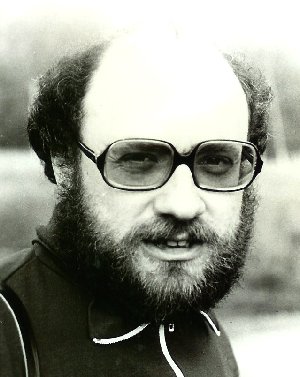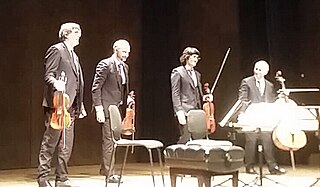![Beatus of Liebana: "The New Jerusalem", Beatus of Facundo [es] / Commentary on the Apocalypse B Facundus 253v.jpg](http://upload.wikimedia.org/wikipedia/commons/thumb/0/00/B_Facundus_253v.jpg/290px-B_Facundus_253v.jpg)
Aquarius is an opera for eight sopranos, eight baritones, and orchestra by Karel Goeyvaerts. It was begun in 1983 and completed in April 1992, to a libretto by the composer in eight languages, incorporating lines from the Book of Revelation.
![Beatus of Liebana: "The New Jerusalem", Beatus of Facundo [es] / Commentary on the Apocalypse B Facundus 253v.jpg](http://upload.wikimedia.org/wikipedia/commons/thumb/0/00/B_Facundus_253v.jpg/290px-B_Facundus_253v.jpg)
Aquarius is an opera for eight sopranos, eight baritones, and orchestra by Karel Goeyvaerts. It was begun in 1983 and completed in April 1992, to a libretto by the composer in eight languages, incorporating lines from the Book of Revelation.
Aquarius in its final form is an opera, but its composition involved a number of preliminary pieces for various forces, so that Goeyvaerts preferred to speak of the "Aquarius project". Goeyvaerts's inspiration came from principally four sources: Marilyn Ferguson's book The Aquarian Conspiracy (which he was given in 1983 by his friend Boudewijn Buckinx), the astrological theory of epochs, the Revelation of St. John, and the commentary on the Apocalypse by the 8th-century exegete Beatus of Liébana [1] [2]
Because no large, single commission for the entire opera was initially offered, Goeyvaerts set about composing the components separately, often for smaller forces than he intended for the definitive version. In this way, nearly all of his works from 1983 onward are related to Aquarius in one way or another. At last a commission from the Brussels Opera and deSingel, later joined by Antwerp '93, enabled Goeyvaerts to complete the opera in April 1992. When he suddenly died on 3 February 1993, he had not finished correcting the manuscript for publication. This task was carried out by Mark De Smet. [3]
The libretto does not consist of the conventional succession of vocal monologues, dialogues, and ensembles, and there is no narrative structure to the text. Goeyvaerts wrote most of the text himself, setting out at the beginning of the opera with non-semantic nonsense syllables and onomatopoeias, moving gradually to the use of more suggested and meaningful words until, in the final scene, coherent lines from the Revelation of St. John are sung in eight languages (Latin, Greek, Dutch, French, German, English, Spanish, and Italian). In this way there is a progression of increasing comprehensibility toward the final scene, which is the only part of the entire libretto where one can reasonably speak of the semantic use of language. [4]
The staged premiere on Tuesday, 9 June 2009, in Antwerp was a co-production of the Holland Festival and the Vlaamse Opera. On 21 June 2009 the production was brought to the Muziekgebouw aan 't IJ in Amsterdam. The performers were the Radio Filharmonisch Orkest and the Nederlands Kamerkoor, conducted by Alejo Pérez. [5]
Aquarius concerns the search for and experience of a new and better society in the Age of Aquarius. The leading feature of this new society is perfect harmony between everyone's abilities his/her place in society. Goeyvaerts found the essential issue not to be the arrival of the traditional idea of the Aquarian society, but that a new society will replace the existing one. Aquarius is intended as a kind of initiational ritual into the secrets of this new society for everyone attending a performance. [6] According to the composer, Aquarius is not about the individual's experiences or conflicts, but rather is a drama of society—today's society, viewed as being in a gradual transition to new relationships between people which can already be observed sporadically. Society is represented on the stage by groups of dancers and singers, and the relationships within these groups represent the evolving structure of society. [7] In Goeyvaerts's own words: [8]

Charles Auguste de Bériot was a Belgian violinist, artist and composer.
Karel August Goeyvaerts was a Belgian composer.
Nummer 2 for thirteen instruments is a composition written in 1951 by the Belgian composer Karel Goeyvaerts.
Henri Léon Marie-Thérèse Pousseur was a Belgian classical composer, teacher, and music theorist.

Alexander Aronovich Knaifel is a Russian composer known for his operas The Ghost of Canterville and Alice in Wonderland as well as for his music for cinema.
Punctualism is a style of musical composition prevalent in Europe between 1949 and 1955 "whose structures are predominantly effected from tone to tone, without superordinate formal conceptions coming to bear". In simpler terms: "music that consists of separately formed particles—however complexly these may be composed—[is called] punctual music, as opposed to linear, or group-formed, or mass-formed music", bolding in the source). This was accomplished by assigning to each note in a composition values drawn from scales of pitch, duration, dynamics, and attack characteristics, resulting in a "stronger individualizing of separate tones". Another important factor was maintaining discrete values in all parameters of the music. Punctual dynamics, for example
mean that all dynamic degrees are fixed; one point will be linked directly to another on the chosen scale, without any intervening transition or gesture. Line-dynamics, on the other hand, involve the transitions from one given amplitude to another: crescendo, decrescendo and their combinations. This second category can be defined as a dynamic glissando, comparable to glissandi of pitch and of tempi.
Frans Geysen is a Belgian composer and a writer on music topics.

Lucien Goethals was a Belgian composer.
Alexandre Rabinovitch-Barakovsky is a Russian-born composer, conductor and classical pianist who lives in Switzerland. He is one of the first composers of minimalism ; "La Belle Musique N.3" (1977) is the first work for orchestra in the minimalist field. He emigrated to Paris from Moscow in 1974, and now lives in Switzerland. He has collaborated with numerous musical artists, notably with the pianist Martha Argerich, with whom he has recorded works by Rachmaninoff and Brahms.
Sonata for Two Pianos (1950–51), also called simply Opus 1 or Nummer 1, is a chamber music work by Belgian composer Karel Goeyvaerts, and a seminal work in the early history of European serialism.
Nummer 5 met zuivere tonen is a musical work by the Belgian composer Karel Goeyvaerts, realized at the WDR Studio for Electronic Music in 1953 and one of the earliest pieces of electronic music.
Pour que les fruits mûrissent cet été is a composition by the Belgian composer Karel Goeyvaerts, for seven musicians playing fourteen Renaissance instruments. It was composed either in 1975 or 1976. A second version for modern instruments was made in 1988.
Votre Faust : Fantaisie variable genre Opéra is an opera in two acts by the Belgian composer Henri Pousseur, for five actors, four singers, twelve instrumentalists, and tape. The text is by the French author Michel Butor. Originally written between 1960 and 1968, it was premiered on 15 January 1969 at the Piccola Scala in Milan, and revised in 1981. Although about seven hours of performable material exists, the variable structure does not permit use of it all in a single version, and performances to date have been between three and three-and-a-half hours.

The Danel Quartet is a French string quartet established in June 1991.
Sources